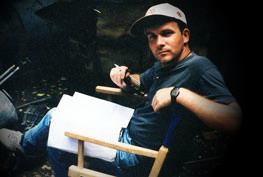
| |
| Home |
| BIOGRAPHY |
| FILMOGRAPHY |
| CURRENT PROJECT |
| PRESS |
| CONTACT |
PRESS
 |
http://www.filmkultura.iif.hu:8080/2001/articles/profiles/istvancic.hu.html Poetic of documentary Initiative of Branko Istvancic film director and author observed and rewarding documentaries, into a Konture rumour has it about poetic other arts short of literature, unfold would, we hope new size magazine and help yours yet once more than visitor... http://www.konture.com/No_4/poetika/branko_istvancic.htm CROATIAN DOCUMENTARY IN THE NINETES http://www.hfs.hr/ljetopis/abstract.asp?tekst=2& In conclusion, documentary
film in the '90s definitely failed to make an artistical record of the
drama that surrounded it. Nevertheless, from the production of the period
one could piece together two programmes of exellent films including Hotel Sunja, Sky over Osijek, Radio station Krapina, Mirila, The
Cormorant Scarecrow, The Duel, BBB, The Hallway and The
Corn Road. These documentaries could easily constitute the list
equal to that of some of the best decades of Croatian documentary. Bunarman by Branko
Ištvančić selected to represent Croatia at the 8th International Short
Film Festival of Sienna Bunarman,a documentary by Branko Ištvančić has been selected to represent Croatia at the 8th International Short Film Festival of Sienna, Italy, from 21 to 29 November 2003 . The film has just been shown at the Kalamata Festival in Greece as the only representative from Croatia.< Bunarman is not only a documentary about an old skill of discovering and digging up wells but also a story about human labour. Almost silent, the film is told through images and remarkable scene settings. Branko Ištvančić is the author of a number of significant Croatian documentaries and it the recipient of the Oktavijan award at this year's Days of Croatian movie. http://www.culturenet.hr/v1/english/read.asp?id=89&cat=1 YOUNG CROATIAN
FILM Hard by numerousness documentaries shot merely for national television legality broadcast, predominantly informative and educative purpose, television had producing swarm artistic high-flying documentaries movie. The Cormorant Scarecrow by Branko Istvancic black - humour curriculum vitae story talk about sometime with wonderful line at an world, for many had the best of Croatian documentaries in 1990-es. Moving into the
Frame http://www.ce-review.org/00/19/kinoeye19_pavicic.html YOUNG CROATIAN
FILM http://www.ce-review.org/99/18/kinoeye18_skrabalo.htm Culture in our
community The Croat community
in Vojvodina in the last decade absolutely experienced the fact that
culture depends on politics. From one side, from the aspect of the state,
Croats are good for obligations like paying taxes or for recruitment
in the army, but not desirable when mentioning it as a minority because
of special rights. From the other hand, in the Croat community, the
culture strongly reflects the opposition of two sides: the Croat political
elite, and the (catholic) Church. Luckily, the concept of culture includes
also things like inspiration, creativity, imagination, which can also
bring some valuable fruits. Still, this is more theoretically than practically
true in the case of Croat community. In 2000, there were only two artistic
works of real value. Both are documentaries: Zvonimir Sudarevic's "Ground"
(Zemlja) with a great ethnological access, and Branko Istvancic's
"Far away disappears the railway". The article contains also short
descriptions of other cultural events, which mostly have a traditionalistic
and populist character. Magyar Szó, |
The Ghost in the Swamp participating at the film festival in Mexico The Croatian children's film The Ghost in the Swamp directed by Branko Istvancic has been listed in the official programme of children's feature movies at the International film Festival to be held in Mexico City from 7th to 12th August 2007. Before that, the film will be presented on 27th and 28th June in the official programme of the 25th Filmfest Muenchen, the second most important festival in German after Berlinale. WELLMAN WELLMAN |